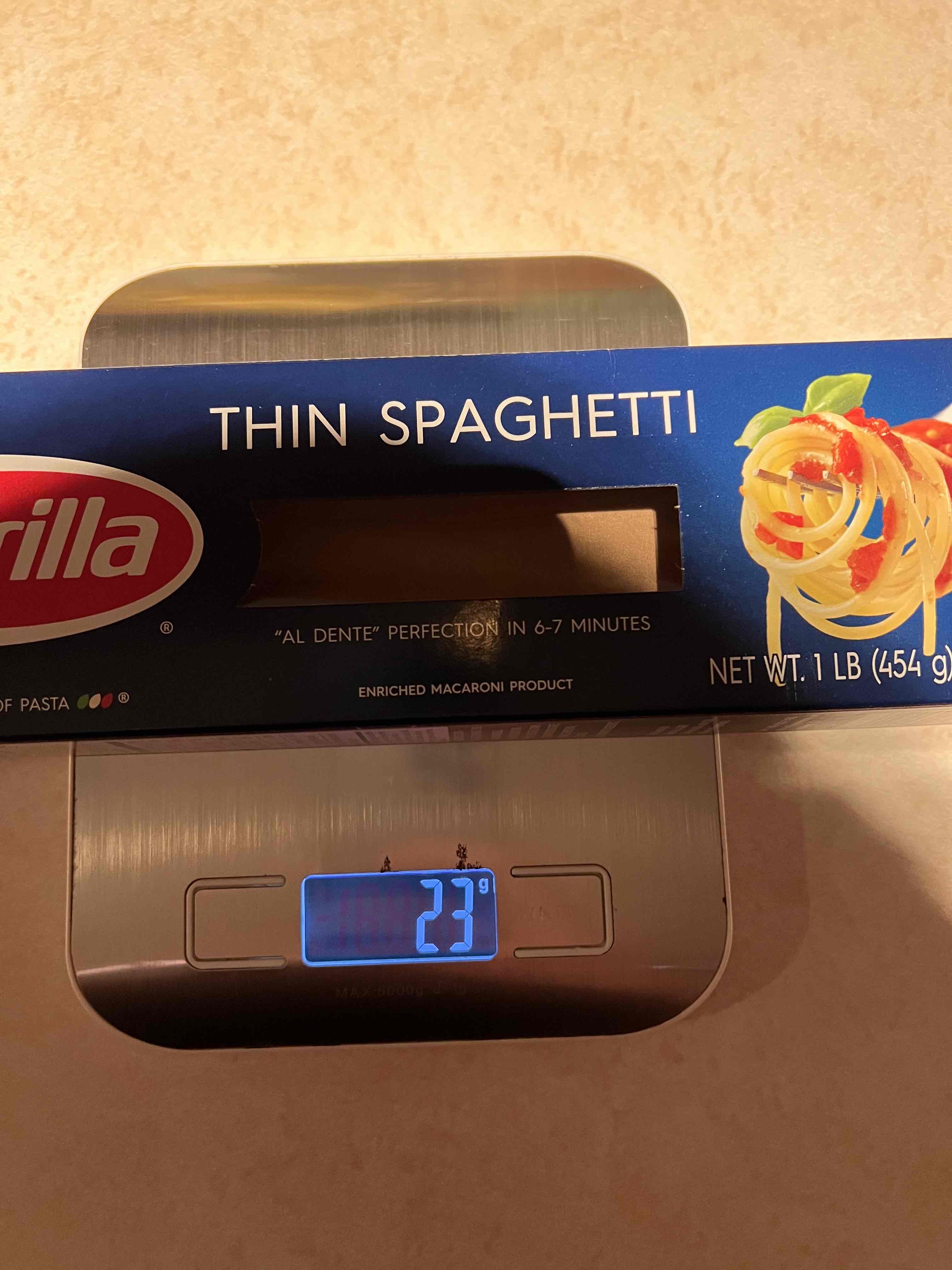I bought 175 g pack of salami which had 162 g of salami as well.
wouldnt weight slightly fluctuate with moisture content?
yeah. 8g is a tiny weight difference here and could easily be accounted-for due to humidity with pasta. it’s about the weight of 3-4 strands of that pasta
Could also just be losing a strand or two in packaging. It happens. That’s why they’re allowed some wiggle room on the packaging weight, and 8 grams is a pretty reasonable margin of error for a product like this.
Shrinkflation is definitely a thing, but this isn’t a good example.
The same package in Germany is 500g, so maybe there is an element of shrinkflation as well.
It’s also why the target is 410 was of 400 I’d imagine .
Idk about that. When I worked in a factory we always measured 510 g into our 500 g packages in order to avoid this happening. You’re getting ripped off and making excuses for it.
So they package it wet? If the weight went down it means the pasta was wetter at time of boxing.
not wet, but probably not nearly as dry, per se. also, fluctuations in temperature (specifically, mass of air in the packaging), as well as calibration issues on the devices- if you use two devices to measure… you’ll always get slightly off measurements.
It’s far more likely that this is just weight variation which is allowable per the Food Safety and Inspection Service
However, I would sooner blame the scale itself as it doesn’t look like a scientific scale. So it’s likely not calibrated and will drift over time. Plenty of things could explain an 8g difference as measured by the average joe.
If it weren’t obscenely expensive to do so, it would make sense for all scales to be calibrated to a NIST traceable standard, with periodic recalibrations at preset intervals.
Most kitchen scales could be easily calibrated with a measuring cup and water if they really wanted to do this. Just have a few included cups for 25,50,100ml of water and then fill them on the scale and tell it what the volume is.
That will easily get you within a gram of error for most common food weights.
If I’m reading table 2-9 right this package would be allowed to be under by 28.3g
Yeah that seems to be how it reads.
Weird that heavier packages are allowed a smaller tolerance ? Like a 198g package can be 28g under, but in the last row anything over 4.5kg needs to vary by less than 1%
yeah, but that doesnt mean much. the hoover damn is still drying.
The Hoover Dam concrete would cure in 125 years by conventional or natural methods. Crews, however, used some innovative engineering methods to hasten the process.
Nearly 600 miles of steel pipes woven through the concrete blocks significantly reduced the chemical heat from the setting for the concrete. Crews relied on 1,000-pound blocks of ice produced daily at the site’s ammonia-refrigeration plant.
Would have doesn’t mean is. Source
Fun fact, concrete actually never stops curing, so I don’t know why they claim they could speed it up. Concrete has to set, dry and cure. You can speed up the first two, but not the last. You can make it reach design spec in say 7 days instead of 28, but it never stops curing.
So is all the water it’s holding back 😱
RH during packing 55%, RH in OPs house 25%
Just different conditions, even
histheir (sorry) neighbors house could have a different RH and different results.
Also, could it be the weight with the box?
When you see “Net weight” or a symbol that looks like a big minuscule “e”, it means that the package weight doesn’t count.
I don’t see anything like that in OP’s picture.
8 grams? I doubt very much a cardboard box only weighs 8 grams.
You’re correct

If you want to get technical, aren’t grams a measure of mass, not weight, so a kitchen scale needs to assume a value for gravity’s acceleration to tell you grams, which could be slightly off depending where you are on earth?
I thought that you were on to something and did a quick google search: the variation is apparently only 0.5%. And a variation that big is only found when comparing a measurement on the poles (heavier) vs the equator (lighter) and I think it unlikely that this pasta was made on Antarctica. So nope, it’s not the reason, they really do owe the op 2 grams of pasta.
tldr; why not both
Volume is not mass, and neither of them is weight. A gram is strictly speaking a measure of mass, and we just consider it to be a unit of weight in casual terms because the only frame of reference the vast majority of us have has reasonably constant gravity so we conflate mass and weight. That you can sort of use grams to measure volume is literally only because the density of common stuff (especially water) is close enough for most purposes. It’s kinda like measuring a distance in units of time so long as the method of travel is known. I can say “an hour’s walk” and I’m not really measuring distance there but you know roughly how far I mean
exactly, youre technically correct, but functionally irrelevant in this context
can I see a pic out the box with it above weight stated?
Yeah what about the other one, like drops on a cold beer?
I think its a fair question from a certain perspective.
However, the law requires that the package contents contain at least as much as stated. If humidity is an issue, it’s up to the manufacturer to factor that in. Besides, this is dry pasta my friend.
I also bought salami. It was 13 g short. It’s produced in the plant 4km from me.
There are no excuses to short the customer and it is illegal.
It is not illegal to sell a single container under the listed net weight.
The net weight must not be under the average weight of a sample of packages. There’s a whole set of rules for maximum allowable variance and for packages under a pound, it’s a little more than 7 grams.
Your scale is almost certainly not accurate enough to tell the difference a few tenths of a gram would make.
ha, define dry (youll need to be precise). how long in the atmosphere is a packaged product warrantied to hold its weight? just curious
No you’re not curious lol You’re doing textbook sea lioning
Go find someone else to mildly anmoy
ha, ok. i thought we were having a conversation. have fun with your mild anger! byeE!
And that’s literally how we got the bakers dozen.
If your dozen of baked goods wasn’t above a threshold you would be harshly punished. So bakers would give an extra so there’s no way they would get in trouble.
Let me introduce you to tolerance in measuring instruments and measuring errors.
Edit: Apparently I’m pro evil companies because I just pointed out that scales (and more importantly non-professional scales) have relatively high error tolerances (+ the measurament method error). Thus the measuring of this pasta and the possible interpretations of it have to take into account that.
When was the last time OP performed a guage R&R with a traceable calibrated mass standard? 😂
Somehow its always lower than claimed.
“Always” is a really strong word that you should not be using in this context since it’s just not true.
For example, there once was more than indicated on a package of lentils in 1958. So it’s clearly not always.
Got em!
Last year this claim went around for the Loblaws No Name brand in Canada so I went shopping with my kitchen scale, preparing to be outraged. Everything was a solid 10% over the advertised weight.
the tolerance exploit
That does not apply in today’s world where shrinkflation and consumer fraud run rampant.
It us solely the company’s responsibility to ensure each package is labeled with the correct weight, not the consumer to tolerate excuses like “measuing errors” whether they’re valid or not. Companies have too much power to just not know or be able to accurately weigh or label their product, ergo if there’s a problem, they chose to have it in there. And if you dispute that, I will simply block you and move on.
Stop defending evil corporations. Stop doing this.
You think tolerances and measuring errors don’t exist just because shrinkflation and fraud are things that exist?
I hate capitalism and corporate bullshit, too, but I don’t need to get outraged at the shit that’s barely an inconvenience like missing 8 grams of spaghetti in a 410 gram package that was mass produced. That shit would happen even if the companies weren’t asshats.
Yes, they are literally just excuses for shrinkflation and companies only benefit from shitheads like you to give them an easy out.
The world doesn’t revolve around tiny minute details and jargon from a field that doesn’t actually positively affect most people’s lives.
Our kitchen scales are the standard, not your overblown overpriced ones that are too precise to be meaningful to the average consumer.
We are in charge, not you.
That’s a lot of words to say “I don’t actually understand how technology works”.
That’s an absurd take, how can a company know anything about whatever random crappy scale you bought second hand?
We have standards for a reason.
surprised this wasn’t a lemmygrad user
All that speech does not change that the weighing scales he is using is cheap af and thus the measuring error is high enough. Even if the guys at the company had the best measuring system in the world without error and they packed 410g of pasta, the guy measuring at home with that scale would probably mesure a vaule not equal to the nominal one.
Maybe the scales have measuring errors because they defend evil corporations. “Please scales stop defending evil corporations!!”. Dude i hate scales they are so much pro system…
Srry your comment was too funny for me.
All that speech doesn’t change the fact that your standards don’t matter, ours do, and if our scales don’t match what that package says, you have to put more product in to make it do so or you are defrauding us. Period.
Now come back when you’re ready to meet our standards.
your standards don’t matter, ours do, and if our scales don’t match what that package says, you have to put more product in to make it do so or you are defrauding us. Period.
I’m not sure if I’m missing a joke here, but are you asking for some alternative-metrology here?!
Weight is a well-defined standard, and a properly calibrated scale > your kitchen scale.
Yeah this guy is pure comedy at this point tbh. Are you of the “our standards” team or “their standards” team (very evil, probably eat childs too)
You aren’t shit. They scales do meet standards that are tested periodically to ensure they aren’t false advertising. Do you really think these corporations don’t have audits?
Calm down, touch grass, try to get in touch with reality and stay off the tankie portions of the internet that feed these delusions.
You sound like an angry oldman not wanting to accept reality.
So you want companies to put excess product because you don’t know how to measure correctly (or don’t have good equipment). Well ask them. For the price of 410g, too? No? And maybe a paycheck supplement too.
I want a lot of things too.
The point is that it isn’t false advertising if you don’t know how to measure well. Is not a standar or whatever you think it is. It’s reality.
Outside the kindergarten where everything seems so simple and easy to understand. In real life you don’t have ideal things. You don’t have an ideal measuring place.
Sources of error when measuring:
- The material cut tolerance.
- Your house not being perfectly smooth leveled.
- (for electronic scales) RF noise.
- (for electronic scales) Tolerance on electronic components.
- The scale subjection points not perfectly pressed.
- (for electronic scales) discretization error.
- Components degradation.
- Humidity.
- Gas denisty near the scale.
- Gravity fluctuations in the region of measurement.
- Surface of the sample not resting completly in the scale plate. Etc.
And you are ranting about evil and “our” standards or whatever for a 2% error in the measurement? I would expect a 5% error given all that. That scale must be an exceptional good one.
It’s not standards it’s reality. Why do you think measuring labs are so expensive? Evil companies?
Try measuring your height more than once and see if results change. Hey if they change, you work for the evil companies, and you probably live in our “standards zone”.
Our/Yours standards was pure comedy. It’s getting better and better.
It us solely the company’s responsibility to ensure each package is labeled with the correct weight, not the consumer to tolerate excuses like “measuing errors” whether they’re valid or not
The measuring error is on OP’s end, not the manufacturer.
-2% is probably allowed and this is -1.95%. It’s okay I guess. I’d probably trust my cheap, regularly used and never calibrated kitchen scale less than I would trust these companies to comply with such rules.
Actually it’s usually closer to 5%, but to avoid consumers getting mad most companies have internal variance limits of less. Still, 2% is pretty tight for manufacturing equipment. Despite the mass prevalence of corporate greed, it does end up being better for most companies overall to be on the slightly heavy end of net weight rather than lower end and most manufacturing guardrails and in line weight checks are calibrated with that in mind.
This is entirely due to the risk of images like this going viral and causing blowback for the company. So, to keep products on average a little heavier, posting things like this is great
Hopefully it’s got to average. If they’re cutting 2% off all the time that’s no good
That’s probably what they’re trying to do. The better their quality management is the closer to consistently packing -1.95% they’ll be.
Sup, I’m your local friendly USDA contractor who very much uses scales everyday. Consumer grade kitchen scales are terrible and will lie to you. The fact that it does not go out to the tenths or hundredths is a big flag for accuracy.
We check test our scales twice a year to make sure they are accurate. I once tried check testing my kitchen scale I use for canning for giggles and it failed miserably. It would only register weight on 2 out of 4 quadrants until I got to 10g or so. I’m sure my ohaus is going to show a different and more accurate result if I where to try it.
Eight grams off? That seems rather significant. I mean we use to buy 20 grams of weed we’d know if it was almost half shy.
8g sure but this is only within 2% error. most scales would probably be within 3% so this isn’t surprising
Well, it can’t be packaged to scientific standards, it has to be packaged to ours.
Scale accuracy was never a problem or scrutinized until ow, and successfully helped people lose weight, so it’s not the accuracy of the scales that is an issue.
This is blatant consumer fraud and nothing in your field can change that fact, clearly.
This just doesn’t make sense.
You wouldn’t say the same when talking about other products. If you buy ibuprofen for example you wouldn’t say “it can’t be packaged to scientific standards, it has to be packaged to ours” if you try to weigh a single pill with your kitchen scale.
Stuff HAS to be packaged to scientific standards. Period.
If your tools at home aren’t accurate enough or simply aren’t properly calibrated for a specific job, it can’t be the fault of the producer.
If you use a 2€ kitchen scale that is 10 years old you can’t blame the producer if your measurement is off by 10%.
The producer cannot make sure YOUR equipment is proper for the task, and they can’t make sure EVERYONES scales see the exact same. So of course they have to weigh with their own scales and surprise surprise they use extremely precise scales that are properly calibrated and tested regularly.
Your comment doesn’t make sense, since home tools are not precise enough and that is not the manufacter fault. I suggest you read about Metrology
I think you’re a bit off track. scale accuracy has been a subject of careful scrutiny for millenia. You absolutely have to use the right tool for the job. A kitchen scale is not the right tool for the job. It would be like complaining that you can’t take your car’s lug nuts off with a pipe wrench.
Scales used for commercial purposes, such as weighing the amount of product in a package, are regularly calibrated and checked. Messing with the calibration is considered an economic crime and comes with very harsh penalties.
I remember being in school 20 years ago and being taught about scale inaccuracies and the importance of frequent calibration. The thing about weight loss is that you will lose weight if you’re in a deficit. Your daily calorie needs are going to fluctuate a little bit, regardless. Most people don’t keep activity the exact same, sleep the exact same, take exactly the same steps everyday, plus hormones fluctuate, etc. Your measurements don’t have to be precise, just close enough. People have also lost weight with sloppy volumetric measurements, counting out chips, or even eyeballing the amount of space taken up on their plate. MyPlate.gov was rolled out after consumer research found that it works.
The FDA regulation on Net Weight is found in 21 CFR 101.105. In this regulation FDA makes allowance for reasonable variations caused by loss or gain of moisture during the course of good distribution practice or by unavoidable deviations in good manufacturing practice. FDA states that variations from the stated quantity of contents should not be unreasonably large.
While FDA does not provide a specific allowable tolerance for Net Weight, this matter could come under FTC jurisdiction. FTC has proposed regulations that would unify USDA and FDA Net Contents labeling and incorporate information found in the National Institute of Standards & Technology (NIST) Handbook 133.
NIST Handbook 133 specifies that the average net quantity of contents in a lot must at least equal the net quantity declared on the label. Plus or minus deviation is permitted when caused by unavoidable variation in weighing and measuring that occur in good manufacturing practice. The maximum allowable variance for a package with a net weight declaration of 5 oz is 5/16 oz. Packages under-filled by more than this amount are considered non-compliant.
The maximum allowable variance for a package with a net weight declaration of 5 oz is 5/16 oz.
oddly, that’s just over 8g, the difference noted in OP’s example. so, OP’s package is within he allowable tolerance, just.
And it would probably be more expensive to get precision-calibrated equipment to get you at the bottom end of the tolerance to save product cost than what it would cost to just aim for the correct value with less precise equipment.
This one is a conspiracy theory I struggle to get behind. It seems like the conspiracy would be less profitable than the “proper” behavior here.
You know full well that they did some statistical analysis and determined the minimum possible amount of pasta that they could try to put in that box, taking into account variations in their machinery and moisture content.
Big “How much can a banana cost, $10?” energy here.
We’re talking about one of the cheapest brands of commodity pasta here. Think about how much effort you are implying the company put into this versus what 8g of major wholesale flour costs – the only cost they’d really be saving in this conspiracy.
Even at consumer retail prices that’s, what, $0.012 per box? And I bet wholesale prices are at least an order of magnitude less than that. Is the maybe tenth of a percent of cost savings worth a potential class action lawsuit and the horrific pain of Discovery that comes with it? And does that maybe tenth a percent of cost savings even come close to covering all the additional production costs involved in having that machinery calibrated so much more precisely? The juice is not worth the squeeze, my friend.
You think you’re arguing that they would do evil for profit’s sake, but you’re actually arguing they would do evil for evil’s sake even at the expense of profit.
Just so that I’m understanding correctly, you’re saying a company that sells tens of billions of dollars of pasta per year is not interested in saving a penny ot a fraction of a penny per box?
Do you think anyone is going to win a class action lawsuit against a pasta company that 1-5% of the time puts just barely too little pasta in the box. You think we’re going to have that kind of righteous justice? Haha. Do you think people would even be that surprised given that, as you say, “we’re talking about one of the cheapest brands of commodity pasta here.” No, if this was found to be true, whatever regulatory agency would just give them a warning.
It’s not about being evil, is about the way capitalism works. If they’re putting more product in the box than they have to, they’re fools.
And you don’t “precisely calibrate the machinery.” You just figure out what the variations are and you set it to the minimum. If you’re supposed to have something like 9-11 oz of pasta in your box and you know that your machine will give you whatever you set it to, +/- 0.2 oz of pasta, 99% of the time, you set your machine to 9.2 or 9.3 oz. You don’t set it to 10 oz.
4.7 billion is Barillas global revenue, that’s a lot for one person but for a multi-continent good distributor it’s not.
I know you’re angry at the worlds injustices and all but I don’t think the bargain brand dry pasta company is the source of a part of your global conspiracy
Hanlon’s razor: Never attribute to malice that which is adequately explained by stupidity or incompetence.
5/16 oz out of 5 oz is just over 6%.
Thank you! I don’t get why they use such weird measurements. Why not use %?
5/16 oz
How many football fields to the gallon is that? On a serious note this is something far better expressed as a fraction than an amount of difference for one specific container size…
You can’t divide 5/16 by 5?
It’s not really clear whether the variance scales linearly with weight. We only know 1 data point. It could be bracketed for different weight groups.
5/80
Easy 😎
deleted by creator
1/16th
The FDA is probably not operating in what I can only assume is Canada from the Eng/Fra and grams usage.
But I’m sure they have something to allow for fluctuations in weight, would rather it be mandated as a minimum allowing for a bit of extra weight to over compensate however.
A lot of American stuff has English French and Spanish so it can cover the whole continent basically
Yeah, but here in Canada you don’t get Spanish very often, and it would be where the English and French would be. Also the Americans would put both units on the package.
Do Americans set their scales to metric?
I do as well - just because I live in a backwards country doesn’t mean I have to be backwards too
I do.
USDA contractor here, we use metric on the scales we use day to day.
In the nineties, 4oz ground pepper cans made on a line I worked on.
The tolerances were horrible.
McCormick was 3.9 I think
Black and white can 3.5. !!! (25%)
Yes both were made on the same exact line
.5 is not 25% of 4
Why is the basic arithmetic in this thread so terrible?
TBH, I was hungover a piss, and was like fuck it.
Because it’s full of delusional angry people that think there’s a global conspiracy to short consumers tiny percentages of our food to keep us subjugated and poor
On our packaging (Germany) we have a little “e” meaning it will be ± the weight with a deviation of 1.5-9% depending on the volume.
https://www.payback.de/ratgeber/besser-leben/kleines-e-auf-verpackungIt’s a 2% difference. The cutting and packaging is done (most probably) by machines. I have clinically diagnosed OCD, and I wouldn’t care about 8g of missing pasta… How much do you leave on the plate/in the pot/throw away? :)
Otoh, hitting exactly 410g (assuming the scale is calibrated, and you have the same temperature, air moisture and altitude as the factory), is very difficult. They could adjust their machines so the variation hangs a bit more towards the customer, but for them, 2% x millions of boxes = profit.
Most of our packaging machines require < 1%, target <0.5% variance (both ways). Honestly in practice, over a whole batch the total variance is extremely tiny.
Add to this story the accuracy of a household, not-calibrated scale? Yeah I’d say this seems OK.
What do you make?
Tolerances for food items depend a lot on item size, shape, and irregularity.
I mean… that’s a good point. I only make bulk materials, like 1 ton supersaks, and we tend to OVERfill so customers don’t complain, with the target still being close to zero for a whole batch.
That seems around what I’d expect the measurement error to be anyway
This really isn’t a big deal, the customer paid 2% less off this specific box. Oh.
This isn’t a big deal, the customer paid 2% less than the calculated total for their entire order at checkout and only had to say “me shorting this transaction is just a statistical probability and you should view it as the cost of doing business with me.” Oh.
This isn’t a big deal, the customer gets massive subsidies from the government while the poor manufacturers have to pay stupid worker safety fees and unfair payroll during times of extreme economic ‘fortune’. Oh.
🤔Hmm doubt it’s humidity issue the issue. But more importantly why is it not in 500g packets like all the pasta in the world?
Because of shrinkflation
The worst of the flation family.
uh probably lines up with freedom units or cause funny number
More likely shrinkflation. Same as how a pint of hagen-daz is 14oz now, instead of a full pint.
americans really just have to remember a long list of random numbers like how many ounces a full pint is supposed to be, huh.
i’m imagining a whole day of school like, “when people say nickel, they mean 5 cents, a dime is 10 cents, 12 inches is a foot, 3 feet is a yard, water freezes at 32F and boils at 212F…” and the children just crying into their notebooks by the time they get to miles and tons and acres.
When I first read your comment I wanted to say that managing with these units isn’t really all that difficult. But, then I remembered that I have a magnet on my fridge that converts teaspoons to cups to quarts etc. I don’t know anyone who keeps that info in memory. Doubling or halving an American recipe can be an exciting math project
It’s fun to see what metric conversions an American has memorized. If a person can quickly convert miles to Kilometers, they are probably a runner. If you ask a group of colleagues how many grams are in an ounce, the dude who quickly say “28.3 give or take” is a pothead.
A cup is 32 teaspoons, 3 teaspoons per tablespoon, ergo 1 cup is 16 tablespoons. I know this offhand because:
- I cook
- I can count
It’s a base 2 measurement system for the most part. Also highly inefficient and imperfect, but so is metric for cooking.
Well… a tablespoon is 3 teaspoons and a cup is 48 teaspoons. You did get the 16Tbsp per cup right though.
This was a good try!
🤔 Huh. I didn’t believe you until I measured it out on my own measuring spoons. You’re right. My bad fam
Think about us poor Brits, who have an offhand knowledge of the imperial system the American system’s based on, plus the metric system, and usually the formula to convert between them at least for speed, length, and weight.
Hmm, grocery store near me (USA) sells this in 16oz packages, or ~454g
I worked on a manufacturing line for 4oz pepper cans
They had a machine that weighed them and kicked out underweight ones.
The tolerances were horrible.
McCormick was 3.9 I think
Black and white can 3.5. !!!
Yes both were made on the same exact line
Depending on where you live this is actually illegal. In Germany, as example, if you say that something contains 200g it means that there have to be at least 200g inside. If its less, that can cost the producer a lot if he gets fined for it.
Except no. First issue it’s messured wrong. You messure a full package and then an empty one in the factory. Losses during shipping and so on is the problem of the customer. Especially meat looses a lot of water. People don’t weigh the water in the cloth.
Also the little e (estimated sign, 76/211/EEC) besides the package does specially allow variations. Only the entire batch must be correct on average. But there is a limit on how much variations is allowed. And big companies are closely watched.
Ah kk. Didn’t knew that.
*loses
Right. And they actually do it. Another thing: there’s a list here von “Verbraucherschutz” (consumer protection) that lists all products that have less than before in it to the same price, of course it’s on the package, but most people don’t pay attention to it. The “Mogelpackung Liste” (cheat packaging list): https://www.vzhh.de/mogelpackungsliste
If everything you’re measuring is lower than expected, you should check the calibration of the scale. Weigh 2 or 3 things you know the weight of that are at different ranges of weights, light, heavy, medium, and see if any are off. Often a scale will be accurate at only within a certain range and get progressively less accurate as the weight increases or decreases from that range.
Could be worth checking your scale, if everything seems to be underweight. Low battery can show as lower result on some scales
I need to start using old batteries in my bathroom scale.
I use no batteries and am very happy with what it displays.
Fun fact: a US nickel weighs 5.000g, and 5 US quarters weigh 1.0000oz
Woah- intentionally?
If so, that’s amazing. What a clever idea
I have the same scale. I wouldn’t trust it too far, especially combined with the tolerances and humidity weight changes.
Well… Cardboard is quite edible, maybe you should also put it on the balance.
I don’t see anything on the scale indicating it was not tared. Nor do I know whether or not you took a noodle or two out of the pile before weighing
For all we know, you tared this +20g and this is feel-good anti-corporate propaganda. Which is fine, we all hate the corporations…but propaganda is propaganda.
Op, please post a video showing a calibration weight on the scale followed immediately by your pasta taken directly out of a sealed box. For science.























